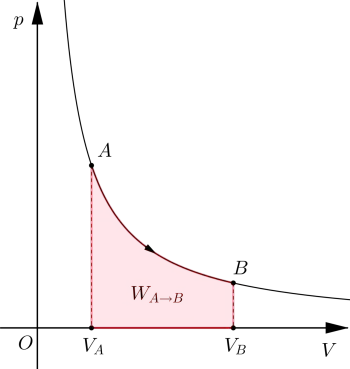
An isothermal process is a thermodynamic transformation in which the temperature of the system remains constant throughout the process. That is, although the state of the system may change in terms of pressure and volume, the temperature does not vary.
These types of processes are especially relevant in the study of ideal gases, since, according to Joule's second law, the internal energy of an ideal gas depends exclusively on its temperature. Therefore, if the temperature is constant, the internal energy will also be constant.
In an isothermal process of an ideal gas, the heat exchanged with the surroundings (Q) is equal to the work done (W):
This means that any amount of heat absorbed by the system is converted into work without causing any change in internal energy.
Examples of isothermal processes
Isothermal processes occur in many natural and technological systems. Prominent examples include:
 Phase changes : The melting of a solid or the evaporation of a liquid occur at a constant temperature. For example, when ice melts at 0 °C , it absorbs heat without changing its temperature until the entire substance has passed into the liquid state.
Phase changes : The melting of a solid or the evaporation of a liquid occur at a constant temperature. For example, when ice melts at 0 °C , it absorbs heat without changing its temperature until the entire substance has passed into the liquid state.- Carnot cycle : Part of the Carnot cycle, a theoretical model of an ideal heat engine, involves isothermal transformations. During these phases, the system exchanges heat with the surroundings while its temperature remains unchanged.
- Refrigerators and heat pumps : In these devices, certain thermodynamic processes, such as the evaporation of the refrigerant in the evaporator, are carried out at a constant temperature to extract heat from the inside of the system and dissipate it to the outside.
- Biological processes : In cellular biology, many metabolic reactions and energy exchange processes occur under isothermal conditions, since cells maintain their temperature relatively stable.
- Expansion of a helium balloon : When a balloon rises in the atmosphere, its volume expands due to the decrease in external pressure. If the process occurs slowly and the balloon exchanges heat with the surrounding air, the temperature of the gas inside the balloon can remain constant, approaching an isothermal process.
- Slow compression of a gas in a piston with highly heat-conducting walls : If a gas is slowly compressed in a cylinder with highly heat-conducting walls, the system can transfer the generated heat to the outside, ensuring that the temperature does not change.
- Deep geothermal systems : In some deep layers of the Earth, the temperature remains almost constant due to thermal equilibrium with the surrounding environment. Heat exchange in these systems occurs without significant temperature variations, approaching isothermal conditions.
- Industrial gas liquefaction processes : In the chemical industry, certain liquefaction and vaporization processes of gases such as oxygen or nitrogen occur at constant temperature, through precise regulation of the heat exchanged with the system.
- Evaporation in an open pot : When water boils at 100 °C at atmospheric pressure, the energy supplied is used exclusively to change the state from liquid to vapor without increasing the temperature, being an isothermal process.
- Compression of gases in diving cylinders : When a gas is slowly compressed in a diving cylinder, the heat generated by the compression is dissipated to the surroundings, allowing the temperature of the gas to remain constant. This process approaches an isothermal transformation if the compression is slow enough for the system to exchange heat with the environment.
Temperature regulation
To maintain a constant temperature during an isothermal process, the system must be in contact with a thermostat or a thermal source with a much greater heat capacity.
This device ensures that any heat absorbed or released is immediately compensated to prevent temperature variations.
Isothermal processes in ideal gases
Ideal gases provide an ideal theoretical framework for analyzing isothermal processes. During isothermal compression or expansion, the gas is kept in contact with a high heat capacity system that ensures that the temperature does not vary.
Isothermal compression
When an ideal gas is compressed isothermally, its volume decreases and the pressure increases. To maintain a constant temperature, the gas must release heat to the surroundings in an amount exactly equal to the work being done on it.
Isothermal expansion
In an isothermal expansion, the gas increases its volume and decreases its pressure. In this case, heat must be supplied to the system to compensate for the work done by the gas in expanding.
Mathematically, the work done by an ideal gas in an isothermal expansion or compression is expressed as:
where:
- \(W \) is the work done,
- \(n \) is the number of moles of the gas,
- \(R \) is the ideal gas constant,
- \(T \) is the absolute temperature,
- \(V_f \) and \(V_i \) are the final and initial volumes, respectively.